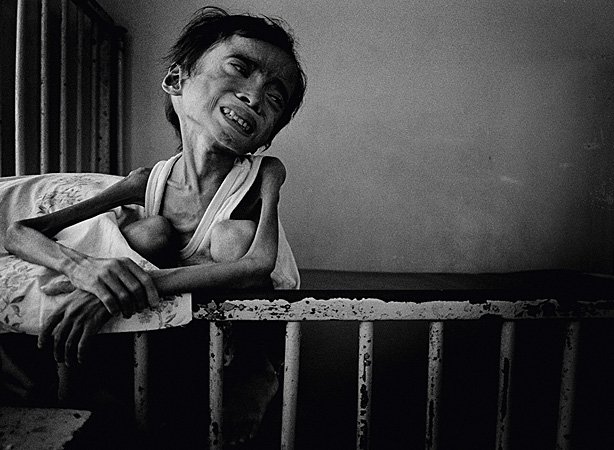Cultural Center of the Philippines
ENCYCLOPEDIA OF
PHILIPPINE ART
Joel Abong
1985 / Photograph / Artist: Kim Komenich / San Francisco Examiner
The photograph of Joel Abong, son of sakada (seasonal cane worker) parents of Negros Occidental, shocked the world and turned attention to the plight of the nation’s extremely poor. Newspaper photographer Kim Komenich of the San Francisco Examiner was in the Philippines in late 1985 to early 1986 to report on the country’s conditions. The international news media had been increasing its coverage on the Philippines in the heady days of protest following the assassination of opposition senator Benigno “Ninoy” Aquino and President Ferdinand Marcos’s battle to preserve his presidency.
Furthermore, world sugar prices were falling and families dependent on a single crop suffered dramatically from greatly reduced income. This, coupled with the neglect of the country’s health sector and the absence of economic opportunities, made itself felt among the most vulnerable segment of the population—the children. Joel Abong suffered from tuberculosis of the bone and died days after this photo was taken. In 2011, Komenich visited Rodolfo and Concepcion Abong, Joel’s parents in Bacolod City. The mother reportedly cried upon seeing the photograph because they were not able to see the picture when the child was still alive and only saw the photo reproduced in magazines after their son’s death.
Rendered in stark black and white, the emaciated body of Joel caused simultaneous feelings of disgust and pity, pathos and discontent. His head appears unusually large on his malnourished body and his eyes become more dramatically anguished as Abong reels from the yawning pain of severe malnutrition and weakening bones. Occupying just half of the pictorial space, the photo literally illustrates the child’s want and a presence that approaches near-absence as he expresses sheer hopelessness to someone from beyond the frame. The bareness of hospital facilities only makes this imaged misery more visceral.
As the photo appeared in newspapers all over the world, the image afflicted the nation’s comfortable economic classes as they were wont to represent and perceive the Philippines only through beautiful images. In contrast, Komenich decided to reveal the hidden misery of the peasantry. Filipinos realized that this image of extreme hunger did not hail from distant Africa, but came from a “democratic republic” amidst a region of rapidly developing economies. This photojournalist’s image of Joel Abong managed to convey to an international public the ironies and tensions in the political, economic, and social life of the Philippines during the 1980s, as seen through the lens of a foreign eye. The photo was able to provide a counternarrative to the propaganda images of the Marcos regime and may have influenced public opinion all over the world at that time, indirectly inspiring various advocacies and social actions supported by the United Nations Children’s Fund and nongovernment organizations.
Written by JPaul S. Manzanilla
Sources
Doyo, Ma. Ceres P. 2013. “Poverty Porn.” Philippine Daily Inquirer, 17 Oct. Accessed 24 Dec 2013. http://opinion.inquirer.net/63489/
poverty-porn.
Revolution Revisited. 2012. “Concepcion and Rodolfo Abong.” Photograph of Joel Abong in 1985 and a video taken of his parents when photographer Kim Komenich visited them in 2011. Revolutionrevisited.com is Komenich’s website on his coverage of the 1986 People Power Uprising. http://www.revolutionrevisited.com/thennow01.
Tinuviel, Luthien. 2009. “Joel Abong, the Sakada Child.” Accessed 24 Dec 2013. http://luthientinuviel.blog.com/2009/01/10/joelabong-the-sakada-child/.
